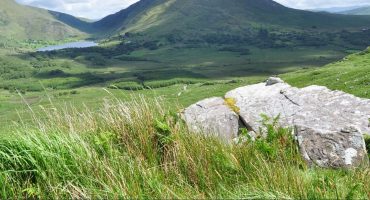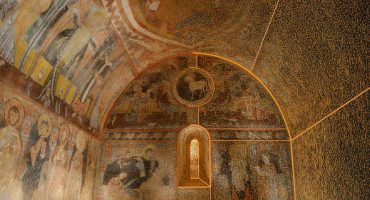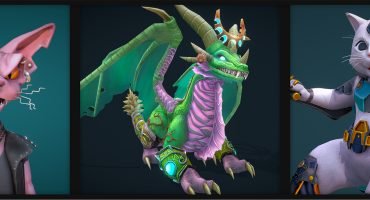New Ways of Seeing
My name is Emily Lankiewicz and I attended Mount Holyoke College, the first women’s college founded in the United States. When I began my studies, I had a variety of interests that did not seem to intersect – I was an art history nerd who also had an interest in computers and coding. Looking back, it is incredibly obvious as to how I ended up on the career path that I have. However, the intersection between history and technology was not so apparent to me initially and I felt as if I had to love those two disciplines separately or to pick one over the other. I had my first bit of exposure to the digital humanities and digitization working as an assistant for DAPS (Digital Assets and Preservation Services) at the Mount Holyoke College Archives and Special Collections. I was starting to figure out how I wanted to meet somewhere in the middle between my interests.
I was fortunate enough to get to spend a semester at the University of Edinburgh in 2016. I was taking an introductory archaeology class when I first was introduced to 3D scanning in the world of cultural heritage – and introduced to, of all things, Sketchfab. I was mesmerized the entire lecture. Because I was only a visiting student, I wouldn’t be able to attend the more focused course on digitization and visualization and nothing like this was being taught at my home institution. Still hopeful to find out more, I reached out to this archaeology professor before I returned home. He was generous enough to give me some of his class materials and a crash course on photogrammetry. When I got back to Mount Holyoke, I began to teach myself how to create 3D scans as part of an independent study.
Below is one of my first test scans, a small figurine that has been in my family for many years. It was photographed glamorously on an ironing board in my laundry room.
From Plaster to Polygons
Part of why I think I got so far in this project was because of the supportive community I was in. If you wanted to try something new, you had someone in your corner at Mount Holyoke and I certainly had my share of mentors.
As an art history major I thought that the museum world was a place I wanted to be, and the only place I could go with my degree. For this new project I knew a museum was the perfect place to experiment and try something new.
There’s a certain reputation that comes with museum environments and the art world as a whole. Sometimes new and experimental is seen as a little scary. There’s a way things have been done, and that’s how they will continue to be done. I certainly felt this initial hesitation when I proposed my project.
I wanted to frame my project New Ways of Seeing in such a way that people would realize that although this is recent technology, the ideas and goals behind its use are nothing new. In fact, as discussed in my project, creating three-dimensional copies of objects is a concept that stretches back to antiquity.
In the nineteenth century, plaster casts were utilized as a form of documentation of sculptures and monuments that allowed for distance learning. One would no longer need to travel all the way to Rome to study works by the masters, but rather to the nearest cast collection. I argue that 3D models pick up where plaster casts left off and improve upon their shortcomings. They continue this concept of accessible art that can be studied in the round from anywhere in the world. Rather than a replacement, 3D models, like plaster casts, serve a complementary purpose. None of these technologies claim to be the original or to replace the original but rather to enhance the museum experience and the act of scholarly study and closer looking.
During the mid-twentieth century, cast collections had fallen out of fashion and were seen as bulky and outdated with the rise of photography. Many cast collections fell into disrepair and were often lost to damp storage. Two-dimensional photographs had won out over physical copies. 3D models could be the modern-day happy medium between the old and new.
I had the wonderful opportunity to work with the Mount Holyoke College Art Museum on my project. This museum is a small institution with fabulous artifacts, a focus on education, and a very much intact plaster cast collection.
Laura Shea, the museum photographer and digital collections coordinator, played a vital role in this project and took me on as her photography assistant as we taught ourselves photogrammetry through trial and error. Hours of processing, photographing, re-processing, re-photographing, eventually building a motorized turntable to save running back and forth between shots (or hiding on the floor out of frame), and many YouTube videos later we figured it out. It wasn’t easy, but this was one of the most fulfilling projects I have ever done.
Art for All
Accessibility was a huge factor for me in this project. My focus in art history was ancient art and of course the source material, being ancient, couldn’t always easily be studied for a variety of reasons. I was lucky enough to have worked at the Mount Holyoke College Art Museum before I began this project, and I knew what wonderful things they had in storage. Being a small museum, it is impossible to physically show your whole collection at once. Even giant museums only have about four to five percent of their collection on public display at a given time. I wanted to show off these treasures, so I was determined to pick things hidden away.
I wanted to choose objects so small they could/often get lost in a large exhibit.
I also wanted to focus on objects that you can’t just look at one time and get the whole story. The object needs to be turned around and looked at from different angles. Many artifacts weren’t meant to be displayed in static settings but rather used from day to day and handled. This format helps bring some of these objects back to life.
Sketchfab has become an invaluable tool of accessibility and outreach for cultural heritage institutions. As a student, having a way to share my work with others from anywhere for free made my project possible and allowed me to breathe some life into the hidden gems of museum storage. The ability to change the lighting scenarios, the textures, and the overall context of an object through Sketchfab’s viewing tools has been an incredible opportunity to look at artifacts differently – a new way of seeing.
Next Chapter
I graduated from Mount Holyoke College in 2017 with a major in art history and a self-designed minor in graphic design and digital media. After graduation, I moved to Atlanta, GA to be an intern at Heritage Werks, a young company that provides professional archival, digitization, and database services to sports teams, fashion clients, entertainment groups, corporations, and many other companies that want to preserve their history and discover what’s tucked away in their own collections. Though most Digital Asset Management (DAM) programs are still catching up with everchanging new medias, it has been wonderful to get to work for a company that is forward thinking and interested in finding new ways to use technology – 3D scanning being one of them. I now have the opportunity as a full-time digital coordinator at Heritage Werks to not only learn new things about the world of technology in archives, but also use all that I’ve learned about photogrammetry and 3D modeling in my next chapter.
Header image: Dwight Hall interior, art gallery, long view of room with plaster casts of ancient classical sculpture, Mount Holyoke College Archives and Special Collections, Buildings and Grounds Records, Dwight Hall, Box 1, Folder 6.



